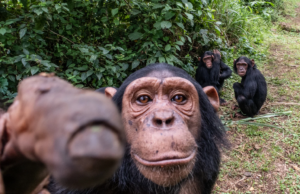Even chimps want to see Justice served

By Kate Wheeling
Chimpanzees and children as young as six will pay to see offenders punished, suggesting justice-seeking behavior in humans has deep evolutionary roots
Humans are social animals. We feel bad when misfortune befalls our friends, and pleasure when it befalls our foes. Plenty of research has documented justice-seeking behavior in adults, even pursuing punishment for offenders who have harmed others rather than ourselves. In a new study, published today in Nature Human Behavior, researchers looked at both children and chimpanzees to find out just how deeply rooted our penchant for revenge is.
“It’s really still a bit of a mystery why we would seek to enforce norms and justice and fairness when it doesn’t concern us and ourselves,” says Nikolaus Steinbeis, a senior lecturer at University College London and co-author on the new study. “What you see in adults and young children is that they’re willing to pay to punish someone when they don’t get anything out of it.”
In an attempt to better understand this phenomenon, Steinbeis and his colleagues looked at children aged four to six in order to pin down exactly when this behavior emerges. In one experiment, a puppet offered participants one of their favorite toys and then handed it over to the child; in another, the puppet offered the child the toy but then kept the toy for itself. Afterwards, the friendly (prosocial) puppet and the mischievous (antisocial) puppets were both physically punished just out of view of the young participants, who could choose to pay with stickers to watch as the punishment was meted out. The chimpanzee experiment mirrored that of the children, except puppets were replaced with humans, toys with food, and stickers with physical effort.
Both chimps and the oldest children were more motivated to see antisocial characters punished than prosocial ones. “What normally happens in evolutionary anthropology is that young children can do something and chimps can’t,” Steinbeis says. “In this case, we actually see really similar behavior in chimps, so this might be something which is rooted quite deeply.”
While children of all ages preferred the friendly puppet to the antisocial one, only the six-year-olds distinguished between the two during the punishment segment of the experiment; they were willing to spend more stickers to watch the antisocial puppet receive its punishment, and they showed a mix of facial expressions, both smiles and frowns, while watching it receive the punishment. The finding suggests that six may be a critical time in development. Steinbeis plans to dig deeper on the neuroscience side of things, to find out “how these findings square up with brain development.”
While few neuroimaging studies have been done in young children so far, there’s promising research from adults on the neurological underpinnings of punishment-seeking behavior. “There’s an interesting finding from neuroscience suggesting that, when we see someone being punished, there’s an activation in the brain region that’s involved in reward,” Steinbeis says.
But while it’s tempting to say that chimps and children may be experiencing something like schadenfreude, it’s too soon to say whether they are actually experiencing pleasure from others’ pain.
Source: https://psmag.com/news/even-chimps-want-to-see-justice-served

 Español
Español
 Português
Português








